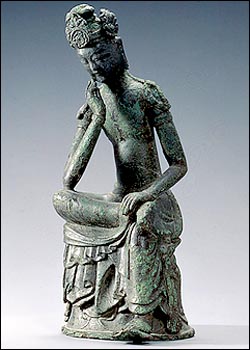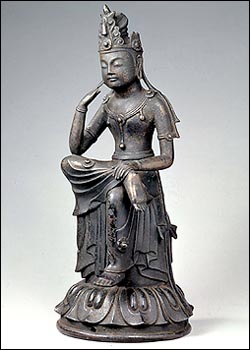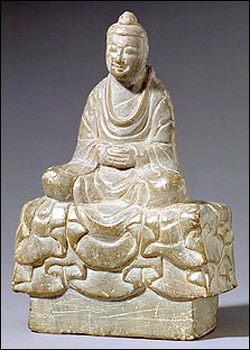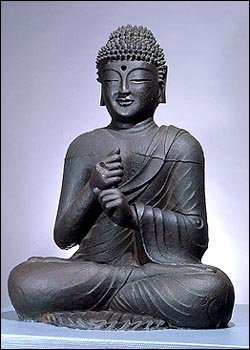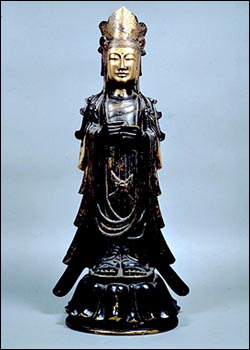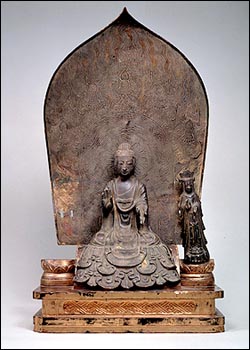|
April 6, 2003 Japanese Art and Its Korean SecretBy HOLLAND COTTER
This cosmopolitan model applies even to "island art," as is suggested by two exhibitions in New York this spring that focus on Japan. Both shows are based on concepts of cultural dispersion, and both in different ways break with established political and institutional views of their subject. "Transmitting the Forms of Divinity: Early Buddhist Art From Korea and Japan," at the Japan Society from Thursday through June 22, goes against the grain of history to present an integrated picture of two East Asian countries that were bitter enemies throughout much of the 20th century. "Great Waves: Chinese Themes in the Arts of Korea and Japan," at the Metropolitan Museum of Art through Aug. 17, tackles similar issues of influence in an interdepartmental collaboration that verges on being revolutionary for a museum that presents art in terms of discrete territorial units. The Japan Society exhibition, which promises to be one of the great Asian shows of the season, has personal associations for me. Nearly 20 years ago, the same institution presented a fabulous little survey titled "The Great Age of Japanese Buddhist Sculpture: A.D. 600-1300," which included three of the same precious gilt bronze images that will be in the new show. One was an eighth-century figure of the smiling infant Buddha, his arm raised high in a "hey, there" salute. Another was a seventh-century jewel-holding bodhisattva, regally robed and crowned, looking like an inverted, bell-shaped flower. The third was a 12-inch-high image thought to be of the Buddha of the Future, Maitreya, called Miroku in Japan, who is shown seated, relaxed, eyes closed, one finger held to his cheek, like a commuter catching a catnap. All three pieces were familiar textbook classics, but I had never seen them "live." After one look at the Maitreya I knew I had to go to the country he was from. A month later, I flew to Japan and spent weeks visiting museums and temples, in cities and in the countryside, from the grand religious centers like Mount Koya to a pilgrimage route of 88 temples, some no bigger than bus shelters, that circle the island of Shikoku. Of the dozens of images I encountered, the most moving was also the most famous: the meditating Miroku at the Koryuji temple in Kyoto. Carved from red pine, it is, in effect, a larger version of the little bronze figure at the Japan Society. It is also a symbol of Japan itself and an embodiment of qualities often used to define Japanese-ness in art: formal simplicity and emotional serenity. To see it was to have an instant Japanese experience. I had mine. As it turns out, though, the Koryuji sculpture isn't Japanese at all. Based on Korean prototypes, it was almost certainly carved in Korea and sent to Japan, along with many other Buddhist artifacts. In addition, some scholars think that the little statue of Maitreya that sent me flying across the world may be Korean too.The catalog for "Transmitting the Forms of Divinity" is full of such news, and it is not neutral information. It means reassigning origin and authorship of objects that are, in some cases, emblems of cultural pride and national self-definition, a sensitive matter given the contentious modern history of Korea and Japan. The two countries, separated by only a narrow stretch of water, have been hostile since Japan occupied the Korean peninsula in the late 19th century, then colonized it from 1910 to 1945, treating Koreans as an inferior, subject people, an attitude more or less adopted in the West with the Korean War. When the occupation ended, Korea severed official connections with Japan and banned all things Japanese. It was only in the 1990's that a thaw began, which culminated in the two countries' co-sponsoring the 2002 World Cup and in Emperor Akihito's acknowledging the Korean lineage of the Japanese imperial family. By then, Korean and Japanese art institutions had already begun to share history-revising research. "Transmitting the Forms of Divinity" is a collaboration between the Nara National Museum in Japan and the Gyeongju National Museum in Korea, under auspices of the Japan Society and the Korea Society, both in New York City, the exhibition's only stop. The material — some 60 sculptures, along with a handful of sutra scrolls and architectural ornaments — is extraordinary in its rarity and beauty. The very fact that two governments have permitted some of their countries' earliest treasures to travel abroad, be exhibited together and, inevitably, be compared is persuasive evidence of rapprochement. And the selection itself required diplomatic tact. Although Japan has a fair number of impressively large early Buddhist sculptures, very few survive in Korea. Rather than risk an impression of aesthetic imbalance, the show's curators — Washizuka Hiromitsu, director of the Nara National Museum, and Park Youngbok, director of the Gyeongju National Museum — factored matters of object size into their final cut by highlighting small early Japanese pieces and adding some large, later Korean sculptures. And what art-historical ground does the exhibition actually break? The fact that Buddhist art was introduced to Japan by Korea is not new, but much of the wealth of clarifying detail is. The show not only establishes various Chinese sources for Buddhist images in Korea, but also unravels the art's complicated development on the Korean peninsula itself, where it was received at different times by three competing kingdoms: Koguryo, Paekche and Silla. Each developed variant forms and styles, which were exported to Japan, where they underwent further transformations. The obvious upshot of the show's detective work is to establish that certain classic "Japanese" pieces are actually "Korean." More important, though, Korea's developmental role in Buddhist art, only glancingly referred to in standard accounts, is revealed to have been crucial, and Japan's debt to its once vassal-neighbor profound. The status awarded Korea at the Japan Society is not reflected in the Met's "Great Waves: Chinese Themes in the Arts of Korea and Japan," which is drawn largely from the museum's collection and takes a broad, traditionally Sinocentric approach to the issue of East Asian cultural flow. At the same time, the very fact that the show is installed in both the Chinese and Japanese galleries is noteworthy. Mixing and matching on this scale is extremely unusual for the Met, and the show has an exhilaratingly radical feeling, the way it might if Picassos were sprinkled through the museum's African collection. The work in the Chinese galleries, organized by Maxwell K. Hearn, a curator in the Asian art department, is arranged by a set of Chinese pictorial themes — water imagery, landscapes, floral motifs — adopted by Japanese and Korean artists. Some cross-cultural relationships are approximate, as in the pairing of a 14th-century Chinese hand scroll by Zhang Yucai, of dragons cavorting in rain clouds, and a bravura two-panel Japanese screen titled "Rough Waves" by Ogata Korin (1658-1716). Other comparisons are finely tuned to point up a dynamic of emulation and interpretation in works made in different cultures, sometimes centuries apart. The other half of the show, installed in the Japanese galleries, is less coherently conceived. And with only a single Korean piece included among nearly 50 Japanese and Chinese works, it reinforces the impression of Korea's cultural invisibility that the Japan Society show takes pains to dispel. Still, provocative ideas are at play in the Met's resourceful reinstallation of its collection, just as they will be, in more focused and innovative form, at the Japan Society. After years of exhibitions proclaiming the "triumph" of this culture or that, the reality of interdependence is being acknowledged even in conventional quarters. Both art and the world are too complex and too fragile to be viewed any other way.
|

